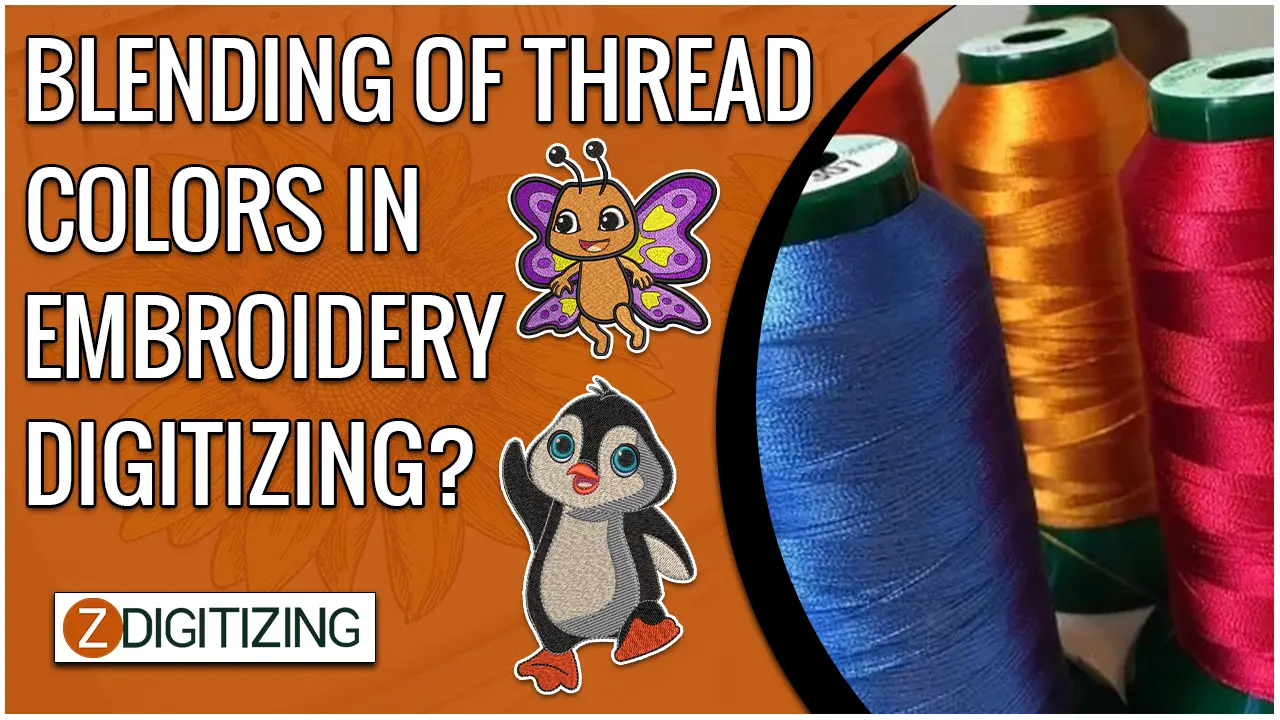Embroidery, a captivating form of textile art, achieves its visual allure through the skillful interplay of colors and stitches. In the realm of embroidery digitizing, the meticulous blending of thread colors is a nuanced technique that elevates the craft to new heights. In this comprehensive guide, we delve into the art and science of blending thread colors in embroidery digitizing, exploring the techniques, considerations, and creative possibilities that come to life with each carefully chosen hue.
1. Introduction: The Palette of Possibilities
Embroidery, whether by hand or machine, transforms a blank canvas into a vibrant tapestry of colors. Blending thread colors in embroidery digitizing expands this palette of possibilities, offering designers a spectrum of shades to create nuanced, realistic, and visually striking designs. From subtle gradients to bold contrasts, the art of blending threads adds depth and dimension to embroidered creations.
2. The Basics of Thread Blending in Embroidery Digitizing
2.1 Understanding Thread Blending
- Thread blending involves seamlessly transitioning between different thread colors within a design. This technique is particularly effective in creating smooth gradients, realistic shading, and intricate details, mimicking the visual effects found in traditional art forms.
2.2 Utilizing Thread Density
- Thread density plays a crucial role in thread blending. Adjusting the density of stitches allows for controlled color transitions. Dense stitching can intensify color saturation, while sparse stitching creates a softer blend, contributing to the overall aesthetic of the design.
- Good News: If you are looking for vector art services and embroidery digitizing, Then ZDigitizing is best choice for you. Zdigitizing is a professional company that provides complete digitizing and vector art services worldwide.
3. The Art of Color Selection
3.1 Choosing Compatible Colors
- The key to successful thread blending lies in selecting colors that naturally complement each other. Understanding color theory, such as complementary, analogous, or monochromatic color schemes, guides the designer in choosing hues that blend seamlessly for a harmonious effect.
3.2 Experimenting with Gradient Effects
- Gradient effects in thread blending involve transitioning from one color to another gradually. This technique is especially impactful in creating realistic depictions of light and shadow. Designers can experiment with different gradient styles, such as linear, radial, or even custom gradients tailored to the specific design.
4. Techniques for Thread Blending in Embroidery Digitizing
4.1 Satin Stitch Blending
- Satin stitch blending involves using satin stitches with varying densities to create a smooth transition between colors. This technique is effective for achieving a glossy, continuous surface with subtle color shifts.
4.2 Running Stitch Gradient
- The running stitch gradient technique employs running stitches of varying lengths and densities to create a gradient effect. This method is versatile and suitable for both intricate details and larger areas, allowing for flexibility in design.
4.3 Layering and Stitch Direction
- Layering multiple thread colors and controlling stitch direction contribute to the blending effect. By strategically layering stitches in different directions, designers can create textures and tones that simulate the appearance of brushstrokes in a painted canvas.
5. Considerations for Effective Thread Blending
5.1 Fabric Selection
- The type of fabric chosen for embroidery impacts thread blending. Different fabrics absorb colors in varying ways, influencing how the threads interact. Conducting tests on sample fabrics helps determine the optimal blending techniques for a specific material.
5.2 Thread Type and Thickness
- Thread type and thickness influence how colors interact. Variegated threads, which change color along their length, can add dynamic effects to blending. Similarly, adjusting thread thickness can enhance or soften the transition between colors.
5.3 Design Complexity
- The complexity of the design plays a role in determining the approach to thread blending. Intricate designs may require more meticulous planning and finer details in color transitions, while simpler designs may allow for bolder contrasts.
6. Advanced Techniques in Thread Blending
6.1 Thread Painting
- Thread painting is an advanced technique that mimics the brushstrokes of a painter. It involves layering threads with varying densities and stitch directions to create intricate details and realistic textures. This technique is often employed in creating lifelike portraits and detailed scenes.
6.2 Color Mapping and Digitizing Software
- Color mapping in digitizing software allows designers to assign specific colors to individual stitches. Utilizing this feature enables precise control over thread blending. Digitizing software with advanced capabilities can automate parts of the blending process, providing efficiency and accuracy.
6.3 Overlapping Stitches for Blurring Effects
- Overlapping stitches intentionally blur the lines between thread colors, creating a soft and diffused effect. This technique is particularly effective in creating watercolor-like designs where colors seamlessly merge into one another.
7. Inspiration from Nature: Embracing Realism in Thread Blending
7.1 Mimicking Natural Gradients
- Nature serves as a rich source of inspiration for thread blending. Emulating natural gradients, such as the changing hues of a sunset or the delicate shades of flower petals, allows designers to infuse realism into their embroidered creations.
7.2 Capturing Light and Shadow
- Thread blending is a powerful tool in capturing the interplay of light and shadow. By carefully blending threads to simulate highlights and lowlights, designers can achieve a three-dimensional quality that brings their designs to life.
8. Challenges and Solutions in Thread Blending
8.1 Maintaining Consistency
- Consistency in thread blending across multiple items can be challenging. To address this, meticulous testing and calibration of embroidery machines are essential. Creating detailed guidelines for production ensures uniformity in the final output.
8.2 Addressing Thread Tension Issues
- Inconsistent thread tension can result in uneven color blending. Regular maintenance of embroidery machines, including checking and adjusting thread tension, is crucial to address this challenge and achieve a seamless blending effect.
8.3 Handling Small Details
- Blending small details, such as intricate facial features or fine lines, requires precision. Utilizing finer thread and adjusting stitch density can help maintain clarity in small details while achieving the desired blending effect.
9. Conclusion: A Tapestry of Colorful Expression
In conclusion, the art of blending thread colors in embroidery digitizing opens a realm of possibilities for designers to express their creativity. From mastering fundamental techniques to exploring advanced methods, the journey of thread blending is a continuous exploration of color, texture, and form. As technology advances and design possibilities expand, the tapestry of colorful expression in embroidered creations continues to evolve.
Zdigitizing
We trust this article might really work out for you. To digitize embroiery plan you would require an expert like ZDigitizing, as digitizing is a mind boggling process.
Zdigitizing is a embroidery digitizing organization that gives embroidery digitizing service and vector craftsmanship benefits all around the world to organizations, ventures, and enterprises. Zdigitizing gives fashionable, strong, and sensible custom digitizing embroidery and vector craftsmanship administrations. We have been conveying first class digitizing embroidery administrations for 20+ years.
If you are looking to digitize your embroidery designs, zdigitizing is a reliable and professional company that provides complete digitizing and vector art services worldwide.
Hope it will be helpful for you guys!
FAQs
-
Can thread blending be achieved with all types of embroidery machines?
- Thread blending can be achieved with various types of embroidery machines, but the capabilities may vary. High-tech machines with advanced features and digitizing software offer more control and precision in thread blending. It's essential to choose a machine that aligns with the desired blending techniques.
-
How can I ensure consistency in thread blending across a large production run?
- Consistency in thread blending across a large production run requires meticulous testing, calibration of machines, and adherence to detailed guidelines. Regular maintenance of embroidery machines, along with quality control measures, helps ensure uniformity in the final output.
-
Are there specific thread types recommended for effective blending?
- The choice of thread types depends on the desired effect. Variegated threads, which change color along their length, can add dynamic effects to blending. Additionally, experimenting with different thread thicknesses allows designers to achieve varying degrees of blending and texture.
-
Can thread blending be used for both intricate designs and larger areas of embroidery?
- Yes, thread blending can be adapted for both intricate designs and larger areas of embroidery. Techniques like satin stitch blending, running stitch gradients, and layering stitches are versatile and can be applied to different design complexities and sizes.
-
How does fabric selection impact thread blending in embroidery digitizing?
- Fabric selection significantly influences thread blending. Different fabrics absorb colors in varying ways, affecting how the threads interact. Conducting tests on sample fabrics helps determine the optimal blending techniques for a specific material, ensuring the desired visual impact in the final embroidered piece.


No comments yet